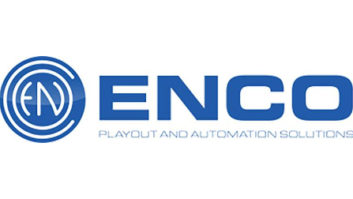(click thumbnail)Fig. 1: Chris Kelley created this time-saving relay simulator switch box.Multiple sites or cluster stations usually mean multiple satellite feeds and their associated multiple Starguide receivers.
When interfacing these receivers to automation equipment, half the fun is in ensuring that the proper command relay triggers the appropriate event in the automation. In the past, we’d wait through each break, ensuring that the right relay contacts closed. It was a time-consuming problem. When a break was missed, you’d have to schedule your day around the times the relays closed, in an effort to determine if the problem was in the receiver, in the automation or within the wiring connecting the two.
I visited recently with Chris Kelley, market engineer for the Salisbury, Md., Clear Channel cluster. I spied a box with pushbutton switches hanging on a peg in his shop and asked about it. Fig. 1 shows a relay simulator switch box that Chris put together. Talk about a time-saver.
(click thumbnail)Fig. 2: Remove the multi-pin relay plug on the back of the Starguide and plug it into the connector on the relay simulator.
If there is a question about relays firing on command, you remove the multi-pin relay plug on the back of the Starguide (see Fig. 2) and plug it into the connector on Chris’ relay simulator. Now the relay simulator switches are connected directly to the automation.
Press button 1, and the command for relay 1 should be sensed by the automation. If not, you know where to start looking for your problem.
Not only is the box good for troubleshooting; but when your PD adds a new show, the relay simulator ensures the program will properly trip each automation break.
You’ll note in Fig. 3 that Chris wired two cable connectors to the relay simulator. The first cable is for Starguides that use the big 16-relay card. The smaller connector mates with the smaller four-relay port mounted on the audio card. Regardless of the receiver, the interfacing is quick and accurate.
(click thumbnail)Fig. 3: Interfacing is quick and accurate.
I remember in the early days of satellite programming, crouching behind a rack with the probes of a Simpson 260 mashed into the tiny relay screw holes, endlessly waiting for those darned tones to be sent! Hey, welcome to the 21st century! I told Chris he ought to build these and sell them – as if he or any other engineer has the time.
Nonetheless, this is one of those projects that can be built in an afternoon, with a handful of Radio Shack pushbutton switches, a Bud box, some cable and a couple of connectors.
Thanks, Chris, for sharing such a simple, yet useful idea! Chris Kelley can be reached at (410) 742-1923.



. . .
Remote transmitter sites come with their own set of obstacles. In addition to AC power issues, getting reliable telco service to that mountaintop site may be an impossibility.
Rick Fulkerson of Com-Serv in Lake Havasu, Ariz., uses Motorola bag phones with a modem interface to Sine Systems remote controls at nearly a dozen transmitter sites in the state. Because the phone company cannot get lines to the sites, it’s the only choice, and a reliable one. Rick says other remote-control systems can be made to work as well. The only issue is the ring sensitivity adjustment. Cell phones “ring” with a square wave.
Rick says the Sine Systems instruction book more than adequately covers this issue. The modem interface gives you a straight analog phone line to connect to the remote control system. It’s simple and inexpensive, and you cheat lightning; there’s no hard-wire phone line into your shack.
AC to the site can be just a big an issue. Rick says the quote to get power to one of the sites was more than $1 million. He said they’ll be keeping the generator.
. . .
For the eighth year, NAB asked me to present the NAB Radio Show’s Transmitter Workshop. We had over 60 engineers in attendance, on the last day of the show – a great turnout. For those who missed this year’s show, I understand the NAB will be back on the east coast in two years.
(click thumbnail)Fig. 4: Here’s how to reach Stymielock.
Dielectric Communications provided the workbooks for the attendees, as well as Mag lights that were given out during the troubleshooting session for correct answers to troubleshooting problems. Thanks to all who spent the day with us.
During the workshop, a lockout bar that we featured in a previous Workbench column was discussed. Stymielock is a patented bar that permits multiple locks to be fastened to a gate or fence. Each tenant’s lock can be unlocked and reattached without disturbing the other tenants’ locks. Stymielock prevents being locked out by a tenant inadvertently looping his lock through your hasp. Fig. 4 gives the pertinent information for the company. When you call for information, tell them you heard about their product from the pages of Radio World.
Submissions for this column are encouraged, and qualify for SBE recertification credit.













